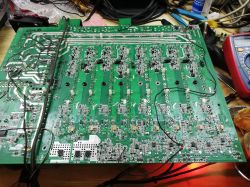Congratulations on the progress, but the damaged duct needs to be repaired so that there is no need to worry about it and continue to carve the converters ...

Czy wolisz polską wersję strony elektroda?
Nie, dziękuję Przekieruj mnie tamMatek920605 wrote:The tester is only a tester - and as "smart" as the one who wrote the program to run it. Many testers cannot check such transistors correctly and show various (!) Stupid things.Should the tester indicate this?

kudlatyy1 wrote:Would anyone draw me up on how to connect without the original power supply? I'm not an electronics engineer, but maybe with your help I would revive him.

kudlatyy1 wrote:should auxiliary AC connect as in the picture? i.e. three gnd points? because your cables go somehow differently.
kudlatyy1 wrote:I do not know how to verify the voltages on the voltage regulators after applying auxiliary power
kudlatyy1 wrote:can I run a channel without one pair of output transistors?
Krzychu1843 wrote:Unfortunately, my copy is not funny when it comes to channels. 2 don't get up at all
Krzychu1843 wrote:Something is mixed up quite a bit, because the fault is lit all the time on all 4 channels - it seems to me that the key to solving this problem is embracing this "arousing" output. When I desoldered the thermal sensor from this channel, the faulty went out nicely (it is worth adding that in this channel - ch4 the voltage value given to the sensor is lower than the rest). I do not know if this will help you (because I do not have 4 of these transistors, so I will not fire with the full power of the converter - I will have fun with it when the channels are operational) but the voltage (looking at the bottom of the board from the side where the relays are located) ) in turn they look like this: + ok97V (ranges from 96.5 to 96.9 but maybe it's the fault of the meter), + 31.5V; -97V; -64V; -31.5V; + 64V.
The converter works at a frequency of about 85kHz.
Returning to the topic of damaged channels - the constant output is within 100mV, so it could be worseFortunately, my bridge survived, but you have to choose something from ultra fast bridges (and if it is not of such power, convert it to diodes).
Yesterday I wrote to the Chinese distributor of these amplifiers (records that are packed in new t.amp kennels) - one distributor told me to wait because he had to contact the engineers department and the other asked for photos showing the defect (I sent graphs collected with an oscilloscope) and silence ... contact broke off
